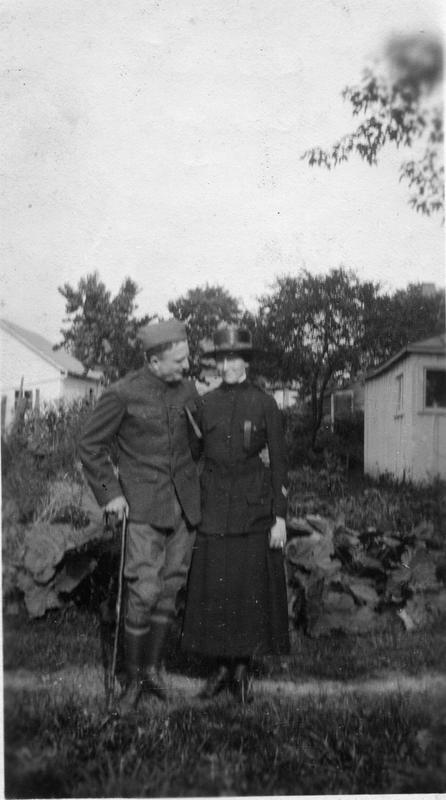Downloads
Full view (jpeg: 68.74 KB)
Learn more about copyright and access restrictions for use of materials from Worthington Memory.
Photograph of Charles Dignan Wing and Harriet Elizabeth Putman in Military Uniform, 1919 is a picture, with genre photograph and group portraits.
It was created in 1919.
Curtis I. Caldwell is the Contributor. Ray Jennings is the Photographer.
This black-and-white photograph shows Charles Dignan Wing and Harriet Elizabeth Putman, both in military uniform. They are standing in front of an area with foliage and small buildings visible in the background. Wing stands with a cane in his right hand, his left hand embraces Putman; she is looking at the camera.
The photograph was taken in North Fairfield, Ohio, Wing's hometown, near the home of Maude L. Barber. Nicknamed "Auntie Barber," she took in and raised Charles Dignan Wing and his two siblings, May Alice and Alan Heckelman, following the deaths of their parents--their mother in childbirth and their father in 1913. All three Wing children attended Hiram College. The picture was probably taken by Ray Jennings, then also of North Fairfield, Ohio, and was likely taken in 1919. Wing and Putman were married on July 7, 1920 at Trinity Cathedral Episcopal Church in Cleveland, Ohio.
Harriet Elizabeth Putman was a 1914 graduate of Worthington High School and served as a U.S. Army Nurse stationed at Camp Sherman, where she met Charles Dignan Wing. While the exact dates of her service are not known, according to research by Putman’s grandson, Curtis I. Caldwell, Wing was positively known to have been stationed at the camp in October, 1918, and was there for a period of at least 12 months but less than 18 months. She is pictured here wearing her “discharge ribbon,” which was the authorization for a discharged veteran to continue wearing their uniform for six months after service. This accommodation for veterans was made following both World War I and World War II, to allow veterans who did not have the money to purchase civilian clothing to wear their military uniforms without risk of being arrested by military police for being Absent Without Leave (AWOL). Putman’s left sleeve shows two downward-pointing service chevrons; each chevron represented six months of service.
Putman served at the camp during the 1918 Flu Pandemic, and herself contracted the flu, which, according to some estimates, killed three percent of the world’s population and more people than died in combat in World War I. At Camp Sherman, 5686 cases were documented, and 1777 died; a local movie theater in nearby Chillicothe was turned into a temporary morgue during the height of the pandemic.
Charles Dignan Wing was severely wounded in July, 1918, in the Battle of Aisne, Champagne-Marne, as a private in the American Expeditionary Force. He spent much of the next few years in and out of hospitals. He still has his right leg in this photo, but it would eventually need to be amputated; family oral history reports that Putman was the nurse who held Wing’s leg during the procedure. He was the recipient of a Purple Heart medal. Wing would go on to hold numerous official positions in Worthington over the course of 37 years--"an unparalleled career of service to the community," according to the Worthington News. Wing first became involved in civic affairs in 1925, when he was hired as the assistant village clerk. At various times during the following years he served as acting city manager, acting safety director, acting service director, acting health director, city clerk, chief deputy clerk, mayor’s clerk, and building inspector’s clerk. In 1942 Wing was named air raid warden for Sharon Township.
Camp Sherman was located near Chillicothe, Ohio. The U.S. entered World War I in April, 1917, and Camp Sherman was one of many camps that were hastily assembled in response. The Army constructed over 2000 buildings on the site in summer, 1917, and the first draftees began arriving in September. The influx of military personnel increased the population of Chillicothe from 16,000 to 60,000, and the camp earned the nickname “Ohio’s Soldier Factory.” Several African-American units, which were segregated at the time, were trained at Camp Sherman. Along with soldiers, the camp was occupied by volunteers and employees such as conscientious objectors and women who worked as nurses. Over 120,000 personnel would pass through the camp between 1917 and its decommissioning in 1921. Part of the land the camp was on has become the Hopewell Culture National Historical Park.
It covers the topic U.S. Armed Forces.
It features the people Harriet Elizabeth Wing (née Putman), 1894-1971 and Charles Dignan Wing, 1897-1963.
The original is in a private collection.
This file was reformatted digital in the format video/jpeg.
The Worthington Memory identification code is wcd0784.
This metadata record was human prepared by Worthington Libraries on February 6, 2025. It was last updated February 10, 2025.

